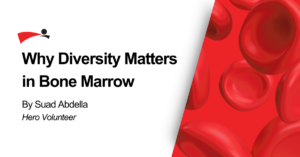Why Diversity Matters in Bone Marrow
Imagine being diagnosed with leukemia and learning that your best shot at surviving is a bone marrow transplant. What makes this more challenging is finding the perfect genetic match. Now, imagine getting told that there is no match simply because only a few people of your ethnic background have registered as donors.
This is a reality for many minority patients every year. According to DKMS, 30% of patients find a donor within their family, and the majority of 70% rely on the national bone marrow registry to find an unrelated match. However, due to the lack of diversity, many patients of color struggle to find a match, which makes them less likely to survive. White patients in the U.S. have a 79% chance of finding an unrelated donor, while Black patients have just a 29% chance of finding an unrelated donor. That number becomes even lower for Hispanics, Asians, and mixed patients. This has more of an impact on patients with sickle cell anemia.
Sickle cell anemia is a disease that affects Black individuals. Currently, the only known solution for this painful disease is a bone marrow transplant. However, “the disease primarily impacts individuals from ethnic minorities that are currently underrepresented.” This is why increasing diversity isn’t just about the statistics, it’s about real people.
Finding a bone marrow match isn’t as easy as a blood transfusion. Humans have HLA markers, which are human leukocyte antigens that are genetically passed down. A successful transplant needs a close enough HLA match to stop the body from rejecting the new stem cell it’s getting fed. Since the HLA markers are passed down, the markers are more similar with people of the same ethnic background.
However, this doesn’t just fall into ethnicity and race. Age is also crucial for transplants. Doctors prefer “donors in the 18 to 44 age group more than 90% of the time”. Our organization takes anyone from 18 to 55, but our target age group is 18 to 30. This is due to the younger stem cells that usually have better transplant results.
You can help bridge the gap between survival and transplants for patients. For many blood cancer patients, a bone marrow transplant can be their last hope. But this can only happen if there are enough donors in general, especially minorities. Because for someone out there, you can be the match they are looking for.

